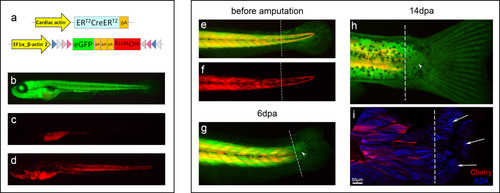- Title
-
Skeletal muscle regeneration in Xenopus tadpoles and zebrafish larvae
- Authors
- Cavaco Rodrigues, A.M., Christen, B., Marti, M., and Izpisua Belmonte, J.C.
- Source
- Full text @ BMC Dev. Biol.
|
Labelled myofibres do not contribute to new muscle during regeneration of zebrafish larvae tail. (a) Representation of the Car-ERCreER and eab2-EGFPTmCherry [52] constructs, which allow the expression of mCherry in muscle fibres after activation of Cre. (b) These transgenics expressed eGFP ubiquitously. (c) Without tamoxifen treatment, mCherry expression was not observed (gut is autofluorescent). (d) After tamoxifen treatment, mCherry was generally visible in many muscle fibres. (e, f) Tails of two weeks old zebrafish larvae were amputated proximal to the base of the fin fold. (g) Six days later, some animals had regenerated a small piece of tail (arrowhead) and a caudal fin. (h) At 14 dpa, the small tail regenerate (arrowhead) continued to be free of mCherry labelling. (i) Confocal image of the same region, showing that the small tail regenerate has muscle fibres (arrows, ASA: α-sarcomeric actin) that are not labelled with mCherry. Pictures e to i correspond to the same animal. Dashed line: amputation plane. n = 33. |
|
Zebrafish larvae show no muscle dedifferentiation phenotype. Micrographs from semithin sections showed that larval tail myofibres have a well organized sarcomeric structure that do not show signs of dedifferentiation during regeneration (arrows). (a, b) At 0 dpa and 1 dpa, distal most fibres show altered sarcomeric striations, characteristic of damaged or dying myofibre (arrowheads). (c) At 3 dpa this phenotype was not observed (neither at 2 dpa, not shown), instead, less muscle is observed close to the amputation plane (asterisk). (d) At 6 dpa, new myofibres are visible in the regenerate (left arrow). Notochord (N) is visible as an oval at 3 and 6 dpa because of the slight dorsal curvature that regenerating tails acquire (see Figure 8h). Dashed lines: amputation planes. n e four sections per animal, three animals per time point. |


